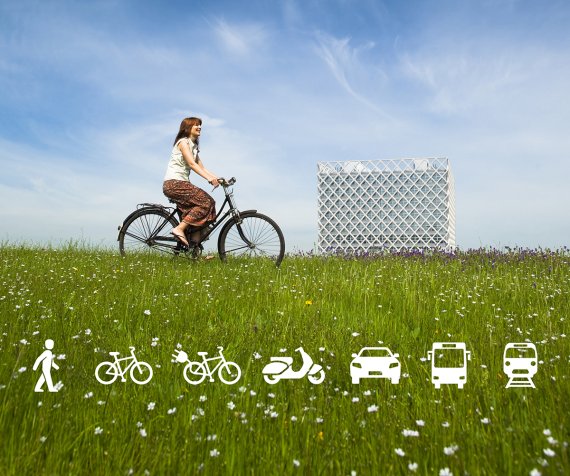Illustration Geert-Jan Bruins
The daily jams on the Mansholtlaan tell a clear story: Wageningen UR has an accessibility problem. Expressed in scores, staff give the campus six out of ten on this point. That is an average for all means of transport; the score for access by car is a little lower. Students are more positive, giving the campus seven out of ten for accessibility. This is because the majority of students live in Wageningen, come by bike and never have to queue. That is, if you don’t count the daily bike jams on the Churchillweg.
More sustainable
These grades come from the latest mobility survey by DTV Consultants, in which students and staff were invited to take part in December. The results provide a nice, representative picture of how we get to the campus, how many kilometres we cover, how long that takes and what scope there is for doing things more sustainably. This was the first such study among students; a similar study among staff was done four years ago.
Accessibility by car was considered barely passable but public transport scored no higher, with a six. Strikingly, the new bus lane across the campus does not seem to have changed much in this regard. Only 3 percent of staff say the new line has influenced their choice of transport. Three quarters of the students cycle to class; the rest come by train or bus. One in 20 students comes by car. The bicycle is popular among staff too, with half the staff cycling to work. That is a lot: one in three counts as a reasonable score nationwide. And yet the proportion of cyclists has dropped by 4 percent compared with four years ago. It is not clear why that it. It might be due to the expansion of the campus, with some departments having moved there from elsewhere in Wageningen.
Half the staff and as many as two thirds of the students say they get held up on their commute to work or class. The issues they mention are access to the campus, the number of bicycles on the Bornsesteeg and the jams on the Mansholtlaan. These bottlenecks are being addressed, mind you. Plans for widening the Mansholtlaan and the Nijenoord Allee are in the advanced stages, as are plans for a northern access road onto the campus. A flyover roundabout at the Bornsesteeg should improve the traffic flow for the crowds of cyclists there.
Out of the car
An interesting question is whether it will be possible to get people out of their cars. ‘Smart travel’ is what DTV Consultants call the aim: going by car when necessary, taking public transport whenever possible. Could we commute more smartly? In theory we could. For every car driver, DTV looked into whether the bicycle, bus or train could be an option. In terms of transport, cycling would be feasible for one in five drivers (the journey is less than 15 kilometres). And one in 20 drivers who live further away could come by public transport.
But it is not as simple as that in reality. Studies elsewhere show that only one in five car drivers are willing to switch to another means of transport. The implication of that for Wageningen is that targeted campaigns won’t persuade more than 2 percent of those currently coming by car to leave it at home.


